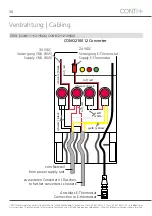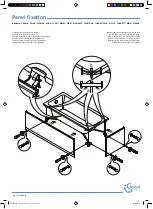
CONTI Sanitärarmaturen GmbH | Hauptstraße 98 | 35435 Wettenberg | Deutschland | Tel. +49 641 98221 0 | Fax +49 641 98221 50 | [email protected]
www.conti.plus | Druckfehler und Irrtümer sowie technische und maßliche Änderungen vorbehalten. | Errors and technical changes remain reserved.
43
Cleaning information
CONTI Sanitärarmaturen GmbH | Hauptstraße 98 | 35435 Wettenberg | Deutschland | Tel. +49 641 98221 0 | Fax: +49 641 98221 50 | [email protected]
www.conti.plus | Druckfehler und Irrtümer sowie technische und maßliche Änderungen vorbehalten. | Errors and technical changes remain reserved.
4
Cleaning information
Surfaces
The most common coating of a sanitary fi tting is the
chrome-nickel surface fi nish which should be cleaned
in accordance with DIN EN 248. This would also
apply to materials such as stainless steel and plastic
as well as surfaces which could include powder and
wet paint, anodised aluminium and galvanised steel.
Coloured, non-metallic surfaces are generally
more sensitive than metallic surfaces, especially to
scratches. It is therefore absolutely necessary to de-
termine the type of surface to be cleaned before
starting the cleaning process.
General information on cleaning and care of
sanitary fi ttings and accessories
In order to meet the market needs in terms of de-
sign and functionality, modern sanitary products
today consist of very different materials and thus
place different demands on the cleaning agents
used and their ingredients.
Cleaning agents and tools
Acids are indispensable as a component of cleaning
agents for the removal of lime deposits.
For sanitary products, however, it is important to
note that:
• Only use cleaning agents intended for the area
of application.
• Do not use cleaners containing hydrochloric
acid, formic acid or acetic acid, as they can
cause considerable damage even after a single
application.
• Only use cleaning agents containing phosphoric
acid in exceptional cases.
• Do not use detergents containing chlorine
bleach.
• The mixing of cleaning agents is generally not
permitted.
• Use of abrasive cleaning agents and equipment,
such as unsuitable scouring agents and pad
sponges, may cause damage.
• Preferably cleaning textiles are used which bind
as few particles as possible. (Knitted towels are
more suitable than woven.)
Tip
Residues of body care products can also cause dam-
age and must be rinsed off immediately after using
the fi ttings and accessories with clear, cold water
without leaving any residue. Ongoing damage to
surfaces that have already been damaged will pro-
gress as a result of the action of cleaning agents.
Recommendations for cleaning and care
The instructions for use issued by the cleaning
agent manufacturers must be strictly followed.
Generally, it should be noted that:
• Cleaning must be carried out as required.
• The detergent dosage and duration of action
must be adapted to the object-specifi c require-
ments and the detergent must never be allowed
to work longer than necessary.
• The build-up of calcifi cation must be prevent-
ed by regular cleaning. Water droplets should
therefore be wiped off with a soft cloth or
chamois leather after use.
• Any limescale deposits must be removed by di-
rect application of detergent if necessary.
• In the case of spray cleaning, do not spray the
cleaning solution on the sanitary fi ttings and
acces sories, but on the cleaning textile (cloth/
sponge) and thus the cleaning is to be carried
out, as the spray mist can penetrate into open-
ings and cracks etc. of the fi tting and accesso-
ries and cause damage.
• Wash cleaning textiles as often and thoroughly
as possible so that only clean cleaning textiles
with out foreign particles are used. Particles de-
posited in cleaning textiles can lead to scratches
and damage to surfaces.
• After cleaning, rinse thoroughly with clear wa-
ter to remove any remaining product buildup.
Surface protection
Lacquered and galvanized surfaces should be pro-
tected with a thin protective fi lm on a regular basis.
The use of a preservative specially formulated for
lacquered or galvanised surfaces is recommended.


































